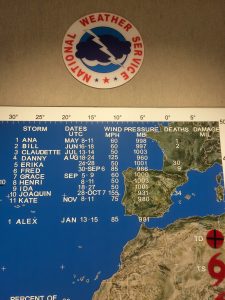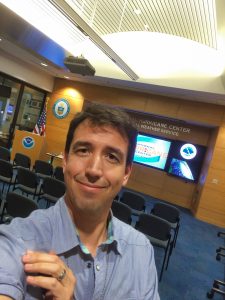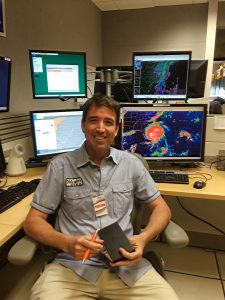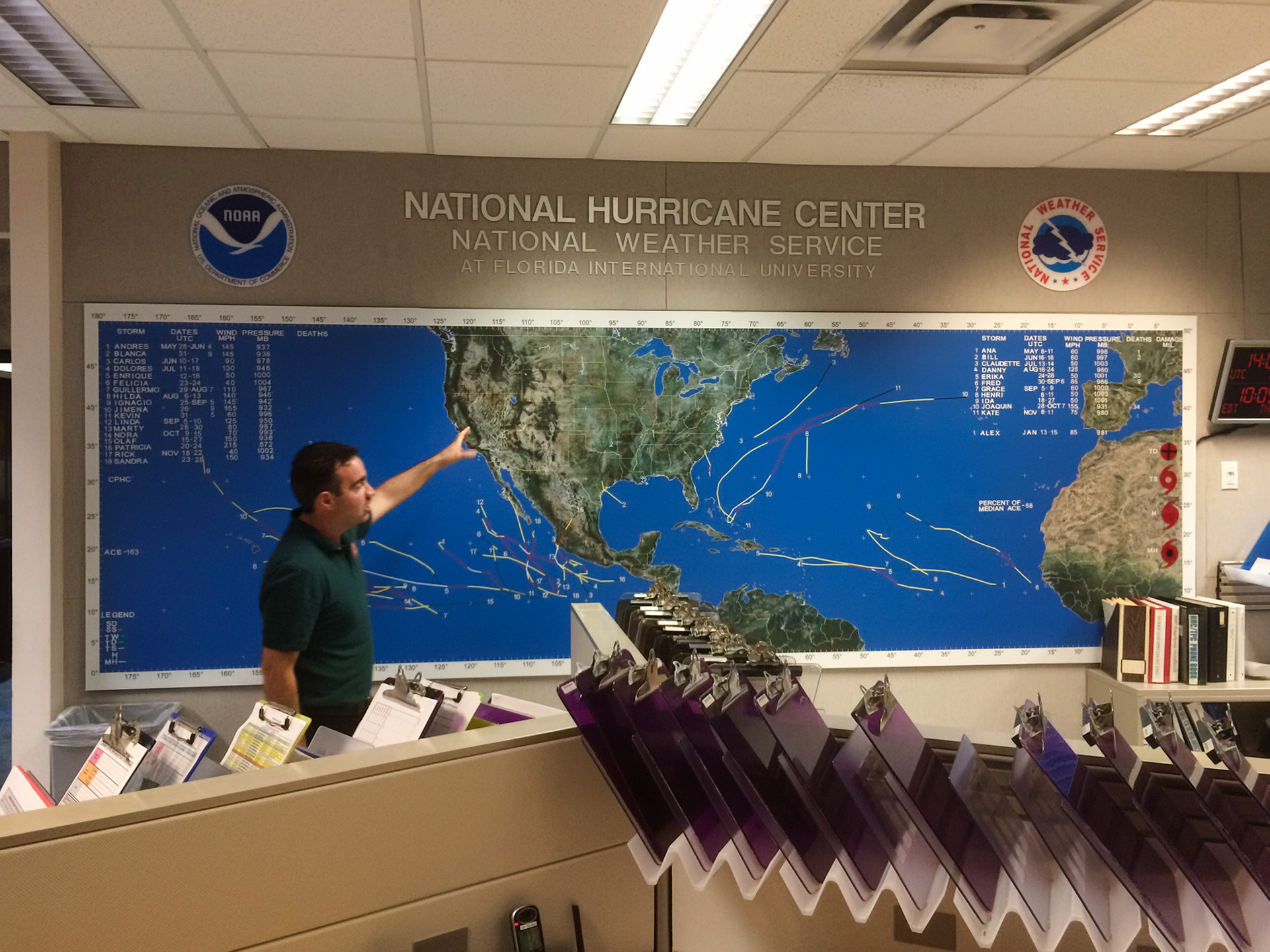National Hurricane Center (NHC)
 The NHC in Miami, Florida, is an independent division within the National Oceanic and Atmospheric Administration (NOAA), and although it is a U.S. government agency, the NHC is THE central recognized information center for tropical storms in the Atlantic and Pacific Oceans worldwide. So where could I find more expertise for my research on hurricanes and storms than in Miami? The problem with Miami is, that it‘s not around the corner from Munich. Emailing my questions would have been the most obvious thing to do, but would the NHC answer questions from a German author? I was skeptical. I also really wanted to visit the NHC in person. I wanted to get to know the people and the premises, soak up the atmosphere and perhaps pick up some insider information that can’t be found on the internet. So I embarked on what should have been a hopeless venture:
The NHC in Miami, Florida, is an independent division within the National Oceanic and Atmospheric Administration (NOAA), and although it is a U.S. government agency, the NHC is THE central recognized information center for tropical storms in the Atlantic and Pacific Oceans worldwide. So where could I find more expertise for my research on hurricanes and storms than in Miami? The problem with Miami is, that it‘s not around the corner from Munich. Emailing my questions would have been the most obvious thing to do, but would the NHC answer questions from a German author? I was skeptical. I also really wanted to visit the NHC in person. I wanted to get to know the people and the premises, soak up the atmosphere and perhaps pick up some insider information that can’t be found on the internet. So I embarked on what should have been a hopeless venture:
Outside hurricane season (February, March and April to be precise), the NHC organizes guided tours and talks for journalists and interested public every 14 days. If you want to have the chance to attend one of these six dates per year, you should register at least one year in advance, as only a maximum of 15 people are allowed per date. However, even if you are accepted, the event may be canceled at short notice if a tropical storm unexpectedly moves towards the USA. With climate change this has become increasingly common in recent years.
„Yes, I Do!“
As my wife and I spend winter seasons in Florida since more than ten years now, I decided to try my luck. In January 2016, I wrote an email to the NHC, convinced that I would receive a rejection. I was more than surprised when the “Public Relations” department replied just two days later. I was lucky, as a participant had just canceled an appointment. Did I want this free slot? Rarely have I replied to an email so quickly. Within seconds, I sent “Yes, I do!” and was the happiest man alive. Shortly afterwards, I was sent an Excel form in which I had to enter my personal details, including my passport number. Being an US government agency, they take things very seriously. A week later they obviously found me to be harmless (despite all the killing and weirdness in my debut thriller “Blow Out”). I got confirmation of my appointment.
 A few weeks later I received an email with precise instructions on where and how the appointment would take place and what I had to bear in mind. For example, I had to have my passport with me and ring the bell at the entrance gate exactly 10-15 minutes before the appointment – no earlier and definitely not later, as the tour was due to start at 11:00 sharp. Come too late and you have to stay outside. Message received. I was also told to be prepared for a personal check, and the list of items I was not allowed to carry with me was impressively long.
A few weeks later I received an email with precise instructions on where and how the appointment would take place and what I had to bear in mind. For example, I had to have my passport with me and ring the bell at the entrance gate exactly 10-15 minutes before the appointment – no earlier and definitely not later, as the tour was due to start at 11:00 sharp. Come too late and you have to stay outside. Message received. I was also told to be prepared for a personal check, and the list of items I was not allowed to carry with me was impressively long.
I got up early the next day. Keep in mind that there was a 3-hour drive to Miami ahead of me, and I knew I had to be on time. Those who have never been to Miami have no idea about the rush hour traffic. Often it is backed up for miles and miles. So, I set off on time, relaxed and in a good mood. What I didn’t know was that my American SatNavigation had noted the address given by the NHC twice – for whatever reason. As I explored the streets somewhere in a rather run-down residential area far outside Miami at around 10:30 a.m., it dawned on me that something was wrong. I had ended up in a completely different part of town, about thirty minutes away from my actual destination. I was starting to panic. At 11:00 a.m. sharp, it was hammering through my brain. If I missed this once-in-a-lifetime opportunity, only because I had been careless when entering the SatNav address, I would jump off the highest bridge in Miami, into the sea, straight into a swarm of hungry hammerhead sharks. I stepped on the gas.
11:00 Sharp
At 11:00 sharp – not joking – I pressed the buzzer on the NHC entrance gate. Despite the air conditioning in the car, I was sweating. The intercom creaked, I stated my request, the gate opened and I breathed a sigh of relief. If ever it was worth committing a dozen traffic violations, just to get there in time, it was this morning.
The security check was quickly completed and I was led into the NHC media room, where press meetings are held during hurricane season. The air conditioning was on full blast and within seconds I was freezing. The multi-media presentation had already begun. A friendly man in his mid-forties was introducing the NOAA organization to the participants. He saw me and waved me over. All heads turned towards me. With an apologetic smile, I sat down on the last bench and felt like I was back in my school days.
Numbers, data, symbols and jumbled lines were constantly flashing.
Joe Cangialosi, NHC meteorologist specializing in tropical storms, spent about twenty minutes giving an overview of the history and mission of the NHC, as well as its various divisions, such as the Hurricane Specialist Unit and the Storm Surge Unit. I was surprised to see how many specialists from different departments work together under one roof. After the presentation, first questions were asked. Then the tour of the premises began, the layout of which can be summarized in one word: Functional. Cold, bare concrete walls. The only “splash of color” is a series of photos of the most destructive hurricanes in recent decades. The desks were neat and tidy, even though a lot of work is still done on paper despite the vast number of computer monitors, PCs and laptops. There are filing cabinets with brown folders everywhere, crammed with computer printouts. We came to a desk with seven monitors in a circle. Numbers, data, symbols and jumbled lines were constantly flashing. A meteorologist explained, how she uses satellite data to monitor weather patterns and developments in the Pacific region from here. The lady seemed tob e very relaxed and took her time – which she was able to do, as the stable weather situation gave no cause for concern.
During the tour, I discovered three old dial telephones in one corner that reminded me of my childhood. The phones were different colors and each had a sticker with a phone number on it. I was told that these were the emergency phones for hurricane evacuations, with direct links to the most important coordination centers. All the while, I was busily taking pictures and notes, because that was exactly the kind of insider information I hab hoped for. (Incidentally, after all the security hoopla beforehand, I was surprised that no one objected to me taking pictures with my smartphone).
Meeting a former Hurricane Hunter
 A little later I was lucky again, because I ran into a former hurricane hunter who had recently taken on a new role at the NHC. These hunters fly specially equipped airplanes right into the eye of hurricanes to collect meteorological data. The tall, lean man wanted to know if I had any questions about the planes. He had come to the right person. I bombarded him with questions and was in turn provided with some very interesting insider information.
A little later I was lucky again, because I ran into a former hurricane hunter who had recently taken on a new role at the NHC. These hunters fly specially equipped airplanes right into the eye of hurricanes to collect meteorological data. The tall, lean man wanted to know if I had any questions about the planes. He had come to the right person. I bombarded him with questions and was in turn provided with some very interesting insider information.
As the end of the tour was slowly approaching, it was time to say goodbye. I took heart and asked Joe Cangialosi if he might had a little more time. I still had so many questions. He smiled; there was still a quarter of an hour left. He patiently answered all my questions, some of which must have seemed quite weird to him, as he had no idea what scenarios were going on in my author’s brain. Later I thanked him and left the NHC. Outside the sun was blazing down from the sky and I warmed up after the frosty temperatures inside the building. With my newly acquired knowledge, I then headed home, now under no time pressure.
Many thanks once again to Dennis Feltgen and John Cangialosi. If you guys will ever read „STORM“ you might find some allusions and hints, as there is a subplot in „STORM“ that takes place in the NHC.
